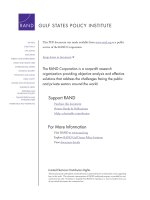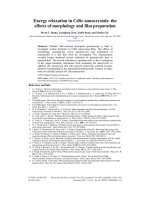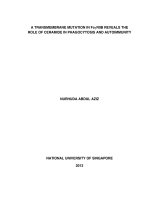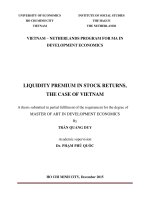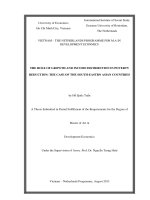Student Displacement in Louisiana After the Hurricanes of 2005 ppt
Bạn đang xem bản rút gọn của tài liệu. Xem và tải ngay bản đầy đủ của tài liệu tại đây (753.5 KB, 157 trang )
This document and trademark(s) contained herein are protected by law as indicated in a notice appearing
later in this work. This electronic representation of RAND intellectual property is provided for non-
commercial use only. Permission is required from RAND to reproduce, or reuse in another form, any
of our research documents for commercial use.
Limited Electronic Distribution Rights
This PDF document was made available from www.rand.org as a public
service of the RAND Corporation.
6
Jump down to document
THE ARTS
CHILD POLICY
CIVIL JUSTICE
EDUCATION
ENERGY AND ENVIRONMENT
HEALTH AND HEALTH CARE
INTERNATIONAL AFFAIRS
NATIONAL SECURITY
POPULATION AND AGING
PUBLIC SAFETY
SCIENCE AND TECHNOLOGY
SUBSTANCE ABUSE
TERRORISM AND
HOMELAND SECURITY
TRANSPORTATION AND
INFRASTRUCTURE
WORKFORCE AND WORKPLACE
The RAND Corporation is a nonprofit research
organization providing objective analysis and effective
solutions that address the challenges facing the public
and private sectors around the world.
Visit RAND at www.rand.org
Explore RAND Gulf States Policy Institute
View document details
For More Information
Purchase this document
Browse Books & Publications
Make a charitable contribution
Support RAND
This product is part of the RAND Corporation technical report series. Reports may
include research findings on a specific topic that is limited in scope; present discus-
sions of the methodology employed in research; provide literature reviews, survey
instruments, modeling exercises, guidelines for practitioners and research profes-
sionals, and supporting documentation; or deliver preliminary findings. All RAND
reports undergo rigorous peer review to ensure that they meet high standards for re-
search quality and objectivity.
Student Displacement
in Louisiana After the
Hurricanes of 2005
Experiences of Public Schools and
Their Students
John F. Pane, Daniel F. McCaffrey,
Shannah Tharp-Taylor, Gary J. Asmus,
Billy R. Stokes
The RAND Corporation is a nonprofit research organization providing objective analysis
and effective solutions that address the challenges facing the public and private sectors
around the world. RAND’s publications do not necessarily reflect the opinions of its
research clients and sponsors.
R
®
is a registered trademark.
© Copyright 2006 RAND Corporation
All rights reserved. No part of this book may be reproduced in any form by any electronic or
mechanical means (including photocopying, recording, or information storage and retrieval)
without permission in writing from RAND.
Published 2006 by the RAND Corporation
1776 Main Street, P.O. Box 2138, Santa Monica, CA 90407-2138
1200 South Hayes Street, Arlington, VA 22202-5050
4570 Fifth Avenue, Suite 600, Pittsburgh, PA 15213-2665
RAND URL: />To order RAND documents or to obtain additional information, contact
Distribution Services: Telephone: (310) 451-7002;
Fax: (310) 451-6915; Email:
The research described in this report results from the RAND Corporation’s continuing
program of self-initiated research. Support for such research is provided, in part, by donors
and by the independent research development provisions of RAND’s contracts for the
operation of its U.S. Department of Defense federally funded research and development
centers. This research was conducted within RAND Education and the RAND Gulf States
Policy Institute (RGSPI).
Library of Congress Cataloging-in-Publication Data
Student displacement in Louisiana after the hurricanes of 2005 : experiences of public schools and their students /
John F. Pane [et al.].
p. cm.
Includes bibliographical references.
ISBN 978-0-8330-4119-7 (pbk. : alk. paper)
1. Education—Demographic aspects—Louisiana. 2. Internally displaced persons—Education—Louisiana.
3. Disaster victims—Education—Louisiana. 4. Public schools—Louisiana. I. Pane, John F.
LC69.5.L68S88 2006
371.809763'021—dc22
2006037140
- iii -
PREFACE
Hurricane Katrina in late August 2005 was the most costly and devastating natural
disaster in U.S. history. The combined impact of this storm and Hurricane Rita, which hit
in late September 2005, left the Gulf Coast region of the United States with tremendous
challenges for recovery and the need to rebuild infrastructure and reestablish services.
The RAND Corporation responded to this national crisis by allocating some of its
flexible research funds to immediately commence several studies of the effects of the
storms and the recovery efforts on the residents of the Gulf region. As part of that effort,
this report focuses on the displacement of approximately 200,000 public school students
in Louisiana.
The purpose of this technical report is to provide timely documentation of many of
the short-term effects of the movements of students that occurred as part of the
displacement of storm victims. The report will help guide educators and policymakers in
their ongoing responses to this disaster and preparations for future events. Focusing on
the Louisiana public school system, it explores the experiences of the displaced students
and the effects of their movements on the state’s public education system during the first
academic year following the hurricanes. This study was carried out between October
2005 and September 2006. It reflects the situation in Louisiana schools through the
conclusion of the 200506 school year. Subsequent changes or developments are not
reflected in this report.
This research was conducted within RAND Education and the RAND Gulf States
Policy Institute (RGSPI). RAND Education is a division of the RAND Corporation. Its
mission is to bring accurate data and careful, objective analysis to the national debate on
education policy. RGSPI is a collaboration between the RAND Corporation and seven
Gulf states’ universities, to assist in long-term recovery efforts by providing evidence-
based policy guidance to facilitate and speed regional recovery and growth, reestablish
services and invest wisely in infrastructure.
The research is part of RAND’s continuing program of self-initiated research,
which is made possible, in part, by the generous support of donors and by the
independent research and development provisions of RAND’s contracts for the operation
of its U.S. Department of Defense federally funded research and development centers.
Additional information about RAND is available at www.rand.org.
- v -
CONTENTS
Preface iii
Figures vii
Tables ix
Summary xi
Acknowledgments xix
Abbreviations xxi
CHAPTER ONE
Introduction 1
Lessons from Hurricane Andrew 2
Research Questions 3
Purpose of This Report and Limitations 3
Organization of This Report 4
CHAPTER TWO
Movement of Students 5
Definitions of Displaced and Relocated Students 5
Data and Methods 6
Student-Movement Results 8
Origins of Displaced Students 8
Characteristics of Displaced Students 10
Parishes Receiving Displaced Students 11
Time Out of School 14
Evolution in the Locations of Displaced Students 15
Enrollment Experiences of Displaced Students 17
Experiences of Students by Parish of Origin 20
Characteristics of Displaced Students by Enrollment Experience 21
Summary of Student Movements 23
CHAPTER THREE
Survey of Principals 25
Sampling Frame 25
- vi -
Sample Design 26
Fielding and Response 28
Weighting to Account for Sample Design and Nonresponse 29
Design Weighting 29
Nonresponse Weighting 29
Grouping 31
Survey Instructions and Definitions of Terms 33
Survey Results 34
The Magnitude of the Student-Displacement Phenomenon 35
Experiences of Displaced Students 36
Steps Taken to Meet the Additional Needs of Displaced Students 45
Effects of Displacement on Staff and Resources 52
Summary of Survey Results 64
Behavior and Mental Health 64
Steps Taken to Meet the Needs of Displaced Students 65
Effects on Staff and Resources 65
CHAPTER FOUR
Findings and Implications 67
Findings on Student Experiences 67
Findings on School Experiences 69
Implications 69
Implications for the Current Student Displacement 70
Implications for Future Preparedness 71
Future Work 72
APPENDIX A
Cleaning and Processing of the LDE SIS Transitions Data 73
APPENDIX B
Survey Questions and Responses 77
References 131
- vii -
FIGURES
S.1. Evolution of the Locations of Displaced Students xiii
2.1. Distribution of Displaced Students, by Original Parish 9
2.2. Map of the Eight Parishes from Which Most Displaced Students Originated 10
2.3. Enrollments of Relocated Students over Time, by the 10 Parishes That Enrolled
the Most Relocated Students 12
2.4. Calendar Weeks Until First Reentry into a Louisiana Public School 14
2.5. Evolution of the Locations of Displaced Students 16
2.6. Percentages of Displaced Students in Four Student-Experience Groups 18
3.1. Explanations of Absenteeism Rated as Likely by Principals 38
3.2. Principals’ Ratings of Displaced Students as More Likely Than Preexisting
Students to Engage in Various Negative Behaviors 40
3.3. Principals’ Ratings of Displaced Students as Less Likely Than Preexisting
Students to Engage in Various Positive Behaviors 41
3.4. Principals’ Reporting of Increases in the Rates of Disciplinary Problems 42
3.5. Principals’ Reporting of Academic and Mental Health Differences Between
Displaced and Preexisting Students 44
3.6. Steps Taken by Those Schools Reporting That They Took Steps to Improve
Attendance of Displaced Students 46
3.7. Principals’ Reporting of Increased Utilization of Various Programs
and Services 47
3.8. Principals’ Ratings of the Importance and Availability of Student Data 50
3.9. Principals’ Reporting of Their Schools’ Needs for Various Types of Staff 53
3.10. Principals’ Reporting of a Reduced Pool of Potential Hires in Various
Job Categories 55
3.11. Principals’ Reporting of Changes in Teacher Stress or Morale 58
3.12. Types of Resources Needed by Schools Reporting Any Such Need After
the Hurricanes 61
3.13. Principals’ Reporting of Greater Challenges Related to Professional
Development 63
- ix -
TABLES
2.1. Race/Ethnicity of Displaced Students, Students in the Source Parishes,
and Students Statewide 11
2.2. Counts of Displaced Students Overall and by Four Student-Experience
Groups, and the Proportions Originating in Six Source Parishes 19
2.3. Counts of Displaced Students Originating in Six Source Parishes, and the
Proportions Falling into Four Student-Experience Groups 21
2.4. Racial/Ethnic Characteristics and Average Test Scores of Displaced Students,
by Experience Group Following the Hurricanes 22
2.5. Comparison of the Prior-Year Achievement of Students in Groups A and D 23
3.1. Number of Schools by Stratum 27
3.2. Final Sample Design, with Number of Schools by Stratum 28
3.3. Response Rates by Stratum 29
3.4. Verification of Nonresponse Weighting 31
3.5. Changes in Total Enrollment from Before the Hurricanes 33
- xi -
SUMMARY
Hurricanes Katrina and Rita caused the largest displacement of students in U.S.
history. In Louisiana alone, the hurricanes displaced nearly 200,000 public school
students in pre-kindergarten through grade 12, more than 26 percent of the pre-storm
enrollment. The purpose of this technical report is to provide timely documentation of
many of the short-term effects of the movements of students that resulted from the
displacement. Such information will help guide educators and policymakers in their
ongoing responses to this disaster and in their planning to prepare for future events.
Focusing on the Louisiana public school system, it explores the experiences of the
displaced students and the effects of their movements on the state’s public education
system during the first academic year following the hurricanes; however, it does not
address infrastructure issues related to storm damage, rebuilding, or cleanup.
This report documents patterns of student movement across the state in terms of the
number of moves, durations of enrollments at each site, time out of school, and the
numbers of students fitting each pattern. It also reports on the effects of the displacement
on schools and their students and on policies adopted in response to serving displaced
students.
Using Louisiana’s student data system, the Student Information System (SIS), we
obtained information about all students in the state who entered or exited a public school
at any time during the 200506 school year as a result of the hurricanes. This information
included the dates of entry and exit from schools, demographic information, and prior-
year test scores. We also surveyed principals from a stratified sample of schools serving
displaced students statewide. The survey included questions about the behaviors of
displaced students, steps taken to address the needs of those students, and the effects of
the influx of students on school resources, staff, and programs.
STUDENT MOVEMENT
In this report, the category displaced students is defined as those students who
entered or exited Louisiana public schools as a result of the hurricanes. A subset of the
displaced students is defined as relocated students while enrolled in Louisiana public
schools other than their original schools. Administrative records from public schools in
the state contain information on more than 196,000 students who were displaced. Over 81
percent of the displaced students came from three parishes (counties): Orleans, Jefferson,
- xii -
and Calcasieu; five additional parishes account for nearly all of the remaining displaced
students: St. Tammany, St. Bernard, Plaquemines, Vermilion, and Cameron. Displaced
students enrolled in other schools in every parish in Louisiana and in 48 other states.
The school-enrollment patterns of these displaced students were complex and
changed throughout the 200506 school year, as shown in Figure S.1. For each day from
August 26, 2005,
1
until the end of the school year, the figure shows the percentages of
displaced students who were in their original schools (medium gray at the bottom),
relocated within their original parishes but not in their original schools (dark gray),
relocated to Louisiana public schools outside their original parishes (very light gray), and
not in Louisiana public schools (light gray at the top).
As shown in the figure, displaced students left the public school system when the
two hurricanes forced them to evacuate or forced their schools to close. Students
displaced by Katrina immediately began to reenroll in schools outside their original
parish, and the number of these relocated students grew over the next few weeks until
Rita struck in late September, causing a second wave of students to be displaced. In early
October, a large group of students returned to their original schools when Jefferson Parish
schools reopened, and another large group returned to their original schools when
Calcasieu Parish schools reopened in late October. However, at that time, a substantial
number of students remained relocated or out of the Louisiana public school system.
From November forward, there was a slow but steady increase in the proportions of
students returning to their original schools or to other schools in their original parishes;
many of the latter were returning to Jefferson and Orleans Parishes. Otherwise, the
proportions of students in each of the four categories were generally stable, with the
largest portion consisting of students who had returned to their original schools and the
second-largest portion consisting of students who were not enrolled in any Louisiana
public school. This latter group included students who enrolled out of state or in
Louisiana private schools, as well as students who were not enrolled in any school. No
existing data source enables the tracking of these students, making it impossible to
determine exactly how many students did not reenroll.
1
August 25, 2005 was the last school day before students began to exit schools
because of the hurricane.
- xiii -
20 40 60 80 100
Date
Percentage of students
8/26/05 10/15/05 11/15/05 12/15/05 1/15/06 2/15/06 3/15/06 4/15/06 5/15/06
abcd
Original school Original parish Other LA public Not in LA
Figure S.1. Evolution of the Locations of Displaced Students.
For all displaced students who were enrolled on August 25, 2005, before the hurricanes, the
figure shows the daily proportions of students in each of four categories throughout the
2005
06 school year. The medium-gray area at the bottom of the figure represents the
proportion of students in their original schools. The dark-gray area above this represents
the proportion of students in their original parishes but not in their original schools. The
very light-gray area represents students enrolled in Louisiana public schools outside their
original parishes, and the light-gray area at the top represents students not enrolled in any
Louisiana public school. Point a denotes the date Hurricane Katrina made landfall. Point b
denotes the date Hurricane Rita made landfall. Point c is the date that Jefferson Parish
schools reopened, and Point d is the date that Calcasieu Parish schools reopened.
The relative stability in the proportions displayed in the figure masks a continued
movement of students. For example, after their initial reenrollment, many displaced
students continued to change schools and a substantial number left the public education
system entirely. At the end of the school year, 10,000 students who had reenrolled at
some time after the hurricanes were no longer enrolled in Louisiana public schools.
As suggested by this figure, many students missed a substantial amount of
schooling following the storms. Among students who returned to Louisiana public
schools, the median amount of time out of school until the first reenrollment was five
weeks. Twenty-five percent missed less than three weeks of school, and 20 percent
missed more than seven weeks. Additional school transfers after the first reenrollment
often caused students to lose additional school time.
- xiv -
To summarize the experiences of individual displaced students, we classified
students into four groups according to their yearlong enrollment patterns. Thirty-eight
percent of displaced students were out of their original schools temporarily and then
returned to the same school without enrolling in any other Louisiana public school.
Another 31 percent relocated, including 7 percent who returned to their original schools
after temporary relocation and 24 percent who did not return to their original schools for
the duration of the 200506 school year. Finally, more than 31 percent of displaced
students, including the majority of Orleans Parish students, did not enroll in any
Louisiana public school for the remainder of the school year, either relocating to other
states or to Louisiana private schools or not enrolling in any school.
Nearly 65 percent of the displaced students were members of racial/ethnic minority
groups, compared to 59 percent in the overall enrollment of the eight parishes listed
above and 52 percent statewide. Blacks were the largest minority group, at 58 percent in
the displaced-student population, 53 percent in the eight parishes, and 48 percent
statewide. The group of students who did not enroll in any Louisiana public school for
the remainder of the school year included a disproportionately large percentage of black
students and students who were achieving poorly before the hurricanes—characteristics
of risk for academic failure.
SURVEY RESULTS
The goals of the survey of principals were to provide greater detail than would be
available in administrative data on the experiences of schools following the hurricanes
and to determine schools’ responses to challenges presented by enrolling displaced
students. It inquired about topics such as the number of displaced students enrolled; how
displaced students compared with the school’s preexisting students on demographic
characteristics and achievement; the experiences of the displaced students in terms of
attendance, social adjustment, and disciplinary incidents; effects on resources, activities,
and the hiring and training of staff; and the effects on services provided by the school.
To analyze survey responses, we divided schools into two groups—high-PEDS
(percentage of enrollment by displaced students) and low-PEDS schools—which together
make up 99.7 percent of Louisiana public schools serving at least one displaced student.
The average total enrollment in both high-PEDS and low-PEDS schools was
approximately 510 students in January 2006, four months after the hurricanes. Displaced
students, including those who were enrolled pre-hurricane and who returned afterward,
accounted for at least 84 percent of enrollment in the high-PEDS schools. These schools
- xv -
tended to be schools that closed for some period because they were directly affected by
the hurricanes and later reopened. They accounted for 77 percent of displaced students in
our dataset who were enrolled and 45 percent of relocated students. However, because
many of the original students from these schools relocated to other areas, high-PEDS
schools experienced enrollment declines from the prior year averaging 10 percent. High-
PEDS schools were concentrated in a few parishes: 46 percent in Jefferson, 33 percent in
Calcasieu, and 6 percent in Orleans. In low-PEDS schools, displaced students accounted
for less than 36 percent of enrollment. These schools were more likely to be outside of
the areas directly affected by the hurricanes, with the displaced students relocating from
other schools and joining more-stable populations of preexisting students who were not
displaced. Low-PEDS schools experienced an average enrollment increase of 4 percent.
A goal of the survey was to be able to understand how the enrollment of relocated
students affected school operations and to compare relocated students with the
preexisting student populations in schools. Principals were asked to respond to the survey
to the best of their knowledge, referring to sources such as attendance records only if they
were readily at hand. We instructed principals that we did not intend to burden them with
data gathering, and that approximations were acceptable.
Behavior and Mental Health
The survey asked principals to report on attendance and other behaviors,
disciplinary issues, and mental health needs of displaced students compared with those of
preexisting students. Most principals reported that displaced students attended school
regularly, often more consistently than did preexisting students in the schools. However,
a substantial proportion of schools reported that, among at least some of their displaced
students, there were high levels of absenteeism. Principals most frequently endorsed such
explanations for absenteeism as expectations to return home soon, trips home to check
the condition of property, relocation to another school district, family fragmentation,
parental problems such as those related to employment, and transportation problems.
Overall, the majority of principals reported that the social behaviors of displaced
students were similar to those of preexisting students in the schools. However, when
principals did report differences, displaced students were judged more likely than
preexisting students to engage in negative behaviors, such as fighting, violating school
rules, arguing, bullying, playing in isolation, or eating in isolation; they were also judged
less likely to engage in positive behaviors, such as participating in before or after school
clubs or activities, school-sponsored social events outside the school day, or sports teams.
- xvi -
Principals also frequently reported that displaced students were more likely than
preexisting students to need mental health counseling.
Many principals, particularly in high-PEDS schools, reported increases in the rates
of disciplinary problems, including student tardiness, fights, verbal abuse of teachers,
bullying, cutting class, and theft. However, for each of these disciplinary problems, fewer
principals reported increases in the frequency or severity of these problems than did those
who reported that there was no change.
Steps Taken to Meet the Needs of Displaced Students
Schools took a variety of actions to respond to the needs of displaced students,
including increasing delivery of mental health counseling and tutoring, and undertaking
efforts to improve attendance. Businesses and volunteers also contributed by providing
funding, services, or supplies to help the schools. With the increased demand for services
came a need to expand staffing; however, most schools were not able to hire more staff,
and lack of resources or funding was often cited as the reason.
Although school-admissions policies, such as residency requirements, were
adjusted to be more lenient, every principal was faced with the challenge of determining
the best grade, classroom, and course placements for displaced students. Principals
sought a variety of data to help in the transitioning and placement of students. Ranked as
most essential were documentation of special education needs, current grade-level
placement, and prior-year grades and test scores; however, the availability of this
information was generally reported to be quite low. Principals infrequently cited previous
school districts or the state as the sources of this information; instead, they primarily
relied on parents and guardians or the students themselves to provide this information.
Finally, some principals noted that the pressures of policies related to state testing
and accountability added to the hurricane-induced stresses in their schools.
Effects on Staff and Resources
Enrolling displaced students strained school resources in a variety of ways. Class
sizes increased in more than a third of the schools, and more than half of schools needed
additional classroom teachers and other types of staff, such as substitutes, special
education or resource teachers, teachers’ aides, support staff, and counselors or social
workers. The need for teachers and other staff was greater in high-PEDS schools, and
these schools also reported that the pool of applicants was smaller than in prior years.
Principals frequently reported that these staffing needs went unmet, due primarily to a
- xvii -
lack of funding but also, in some cases, to the lack of qualified applicants. Among
schools that did hire additional staff, it sometimes took considerable time to fill the
positions. However, hiring standards were apparently not compromised: The new hires
were reported to be similar to preexisting teachers in their qualifications. The school
district was the most common source of funding for additional hires. Principals also
reported that rapidly fluctuating enrollment numbers complicated their analysis of
staffing needs and, ultimately, the decisions to hire.
In many schools, principals reported that teachers showed higher levels of stress
than in prior years. Principals reported increased frequencies of work fatigue, job
frustration, and absenteeism among teachers, particularly in high-PEDS schools.
Principals noted that teachers hired to fill vacant positions were often displaced teachers
who were struggling with their own personal problems resulting from the hurricanes.
The needs for additional resources went beyond staff, to include books and
supplies, furniture, transportation resources, and classroom space. In many schools, these
needs were met, sometimes by donations from outside sources; however, in a substantial
number of schools, the resource needs persisted throughout the school year.
Recovery efforts and the strain of serving displaced students had a notable effect
on teachers’ professional development, particularly in high-PEDS schools. Principals
reported that issues related to displacement created new needs for professional
development; yet, they found it more difficult than in the past to provide release time for
teachers to attend. Similarly, principals reported that issues related to displacement
diverted their attention from other activities and issues in their schools and caused them
to postpone activities that already had been planned.
IMPLICATIONS
The report draws the following implications from these results for the ongoing
student-displacement phenomenon and preparedness for future displacements of large
magnitude. The student displacement due to Hurricanes Katrina and Rita persisted
throughout the entire 200506 school year, and it will likely continue. Over the coming
years, it likely will be necessary to continue helping these students recover and to prevent
further damage that could result from untreated mental health problems or continued loss
of schooling. Schools throughout the state and the nation will continue to be called on to
serve these students, and it is imperative that they obtain the resources that they need to
do so and to do it well. In addition, policies and resources to help teachers manage their
own hurricane-related problems and mental health needs might ultimately improve the
- xviii -
services that teachers provide to students. Finally, education officials at both the state and
local levels would benefit from better access to complete and accurate student records
and from a national system to coordinate the two-way sharing of student information
across state boundaries.
- xix -
ACKNOWLEDGMENTS
The authors thank the principals of Louisiana who provided much of the data for
this study by generously taking the time to respond to our survey in the midst of a
challenging year. For assistance with the study and this report, we are also grateful to
RAND colleagues Catherine Augustine, Crystal Baksis, Susan Bodilly, and Naveen
Mandava; and to Robert Gramling of the University of Louisiana at Lafayette, Michael
Ward at the University of Southern Mississippi, and the staffs of the Louisiana
Department of Education and the Center for Child Development at the University of
Louisiana at Lafayette. Finally, we thank Louisiana Superintendent of Education Cecil J.
Picard for his memorandum to principals in support of the survey. Any opinions,
findings, conclusions, or recommendations expressed in this report are those of the
authors and do not necessarily reflect the views of the individuals or organizations
acknowledged here.
- xxi -
ABBREVIATIONS
DCPS Dade County Public Schools (Florida)
FEMA Federal Emergency Management Agency
ID identifier
ITBS Iowa Test of Basic Skills
LDE Louisiana Department of Education
NCE normal curve equivalent
NCLB No Child Left Behind
PEDS percentage of enrollment by displaced students
S.E. standard error
SERV School Emergency Response to Violence
SIS Student Information System
- xxii -
- 1 -
Chapter One
INTRODUCTION
Hurricanes Katrina (in late August 2005) and Rita (in late September 2005) caused
the largest displacement of students in U.S. history. In Louisiana alone, the hurricanes
displaced nearly 200,000 public school students in pre-kindergarten through grade 12, out
of about 740,000 students enrolled before the storms. In areas in which the storm damage
was most severe, students were displaced for the remainder of the 200506 school year.
Schools responded to the stresses of enrolling displaced students in various ways, some
of which may have been more successful than others in mitigating the negative effects of
displacement. This disaster (the pair of hurricanes) affords a rare opportunity to study the
effect of displacement on student experiences and to explore the effects of various
policies that have been adopted in response to such displacement.
Student mobility, the movements of children among schools, has detrimental
effects both on the students doing the moving and on the other students in the schools.
Mobility is associated with lower student achievement; increased dropout rates,
disciplinary problems, and remediation; and slower instructional pace in classrooms
(Astone and McLanahan, 1995; Lash and Kirkpatrick, 1990; U.S. General Accounting
Office, 1994; Wood et al., 1993). These negative effects can have long-term implications
for children’s academic and career attainment; and, in the current age of test-based school
accountability, they can result in penalties for schools that serve displaced students.
In the months after the disaster, the news media reported on a variety of issues
faced by displaced students. For example, evacuees from suburban areas, who are mostly
white and middle-class, were able to relocate closer to their original homes than were
urban residents, who are more predominantly black and low-income (Tizon and Smith,
2005); many displaced students in Louisiana were not attending school at all (Dewan,
2006; Samuels, 2005; Tonn, 2006); schools serving displaced students were experiencing
tensions and problems with student behavior (Herrick, 2005); and many school districts
were struggling with financial concerns due to the costs of educating displaced students
(Hasten, 2005; Klein, 2006). The current study seeks to systematically investigate issues
such as these.

